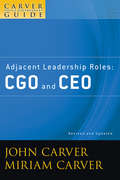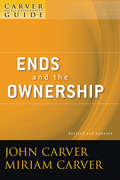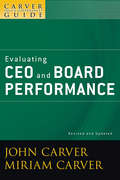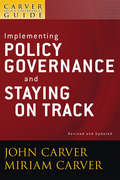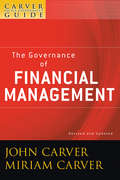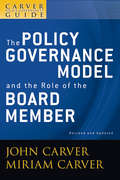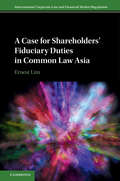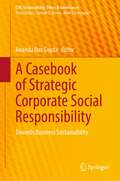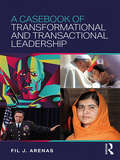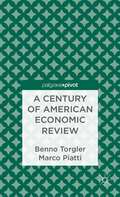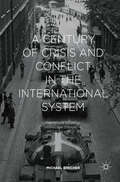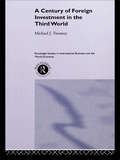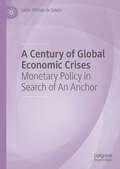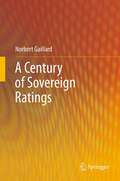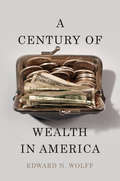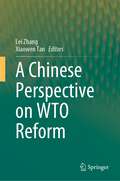- Table View
- List View
A Carver Policy Governance Guide, Adjacent Leadership Roles: CGO and CEO (J-B Carver Board Governance Series #42)
by John Carver Miriam Mayhew CarverThe Carver Policy Governance Guide series includes six booklets that offer board members a description of John Carver's Policy Governance model of board leadership. Policy Governance enables a board to fulfill its accountability to its organization's "owners," whether the owners are association members, city residents, company shareholders, or a community of interest. Policy Governance addresses the board's engagement in financial, programmatic, and personnel matters; roles of officers and committees; reporting and evaluation; agendas; and other aspects of the board job. For boards pursuing, or wanting to pursue, the Policy Governance model, Adjacent Leadership Roles: CGO and CEO examines the leadership roles needed in the boardroom and the executive suite. This guide reveals the two important and separate functions that are key to enabling both governance and management to have the benefit of optimal leadership. The Policy Governance model is based on the functions rather than the structure of a governing board. It outlines commonsense principles about governing that fit together into an entire system. The practices of the Policy Governance board, which are consistent with the principles, allow it to control without meddling, focus on long-term organizational outputs, powerfully delegate to a CEO and staff, and discharge its fiduciary responsibility in a visionary, strategic manner. Because the model is a total system, the Carver Policy Governance Guide series offers boards a complete set of principles for fulfilling their various obligations.
A Carver Policy Governance Guide, Ends and the Ownership (J-B Carver Board Governance Series #37)
by John Carver Miriam Mayhew Carver Carver Governance Design Inc.The Carver Policy Governance® Guide series includes six booklets that offer board members a description of John Carver's Policy Governance model of board leadership. Policy Governance enables a board to fulfill its accountability to its organization's "owners," whether the owners are association members, city residents, company shareholders, or a community of interest. Policy Governance addresses the board's engagement in financial, programmatic, and personnel matters; roles of officers and committees; reporting and evaluation; agendas; and other aspects of the board job. Ends and the Ownership helps boards distinguish between what an organization is for and what it does (ends versus means)—a basic feature of the innovative Policy Governance model. This important guide also discusses the concept of ownership and includes sample policies that can help board members effectively prioritize and govern. The Policy Governance model is based on the functions rather than the structure of a governing board. It outlines commonsense principles about governing that fit together into an entire system. The practices of the Policy Governance board, which are consistent with the principles, allow it to control without meddling, focus on long-term organizational outputs, powerfully delegate to a CEO and staff, and discharge its fiduciary responsibility in a visionary, strategic manner. Because the model is a total system, the Carver Policy Governance Guide series offers boards a complete set of principles for fulfilling their various obligations.
A Carver Policy Governance Guide, Evaluating CEO and Board Performance
by John Carver Carver Governance Design Inc. Miriam CarverThe Carver Policy Governance Guide series includes six booklets that offer board members a description of John Carver's Policy Governance model of board leadership. Policy Governance enables a board to fulfill its accountability to its organization's "owners," whether the owners are association members, city residents, company shareholders, or a community of interest. Policy Governance addresses the board's engagement in financial, programmatic, and personnel matters; roles of officers and committees; reporting and evaluation; agendas; and other aspects of the board job.Evaluating CEO and Board Performance offers board members information on the importance of evaluation as part of a greater systematic view of governance. The guide includes principles for effectively and honestly evaluating CEO and board performance.The Policy Governance model is based on the functions rather than the structure of a governing board. It outlines commonsense principles about governing that fit together into an entire system. The practices of the Policy Governance board, which are consistent with the principles, allow it to control without meddling, focus on long-term organizational outputs, powerfully delegate to a CEO and staff, and discharge its fiduciary responsibility in a visionary, strategic manner. Because the model is a total system, the Carver Policy Governance Guide series offers boards a complete set of principles for fulfilling their various obligations.
A Carver Policy Governance Guide, Implementing Policy Governance and Staying on Track (J-B Carver Board Governance Series #34)
by John Carver Miriam Mayhew CarverThe Carver Policy Governance Guide series includes six booklets that offer board members a description of John Carver's Policy Governance model of board leadership. Policy Governance enables a board to fulfill its accountability to its organization's "owners," whether the owners are association members, city residents, company shareholders, or a community of interest. Policy Governance addresses the board's engagement in financial, programmatic, and personnel matters; roles of officers and committees; reporting and evaluation; agendas; and other aspects of the board job. Implementing Policy Governance and Staying on Track shows boards how they can apply the principles of the Policy Governance model and change the way they govern in practice. The guide cuts across various aspects of the Policy Governance model and challenges board members to move from concepts to practice. The Policy Governance model is based on the functions rather than the structure of a governing board. It outlines commonsense principles about governing that fit together into an entire system. The practices of the Policy Governance board, which are consistent with the principles, allow it to control without meddling, focus on long-term organizational outputs, powerfully delegate to a CEO and staff, and discharge its fiduciary responsibility in a visionary, strategic manner. Because the model is a total system, the Carver Policy Governance Guide series offers boards a complete set of principles for fulfilling their various obligations.
A Carver Policy Governance Guide, The Governance of Financial Management (J-B Carver Board Governance Series #39)
by John Carver Miriam Mayhew CarverThe Carver Policy Governance Guide series includes six booklets that offer board members a description of John Carver's Policy Governance model of board leadership. Policy Governance enables a board to fulfill its accountability to its organization's "owners," whether the owners are association members, city residents, company shareholders, or a community of interest. Policy Governance addresses the board's engagement in financial, programmatic, and personnel matters; roles of officers and committees; reporting and evaluation; agendas; and other aspects of the board job. The Governance of Financial Management offers a proven strategic approach to the issues of finances and board responsibility. It reveals how a board can effectively govern an organization's financial planning by controlling budget values rather than budget numbers. The guide addresses the issue of actual fiscal conditions by creating policies that safeguard an organization's real fiscal health. The Policy Governance model is based on the functions rather than the structure of a governing board. It outlines commonsense principles about governing that fit together into an entire system. The practices of the Policy Governance board, which are consistent with the principles, allow it to control without meddling, focus on long-term organizational outputs, powerfully delegate to a CEO and staff, and discharge its fiduciary responsibility in a visionary, strategic manner. Because the model is a total system, the Carver Policy Governance Guide series offers boards a complete set of principles for fulfilling their various obligations.
A Carver Policy Governance Guide, The Policy Governance Model and the Role of the Board Member
by John Carver Carver Governance Design Inc. Miriam CarverThe Carver Policy Governance Guide series includes six booklets that offer board members a description of John Carver's Policy Governance model of board leadership. Policy Governance enables a board to fulfill its accountability to its organization's "owners," whether the owners are association members, city residents, company shareholders, or a community of interest. Policy Governance addresses the board's engagement in financial, programmatic, and personnel matters; roles of officers and committees; reporting and evaluation; agendas; and other aspects of the board job.The Policy Governance Model and the Role of the Board Member sets out a clear vision for excellence in board leadership. It gives board members an understanding of the concepts and principles that are at the very heart of John Carver's innovative Policy Governance model. This guide details members' main tasks and presents the guidelines needed to transform a board into an effective group that consistently leads powerfully.The Policy Governance model is based on the functions rather than the structure of a governing board. It outlines commonsense principles about governing that fit together into an entire system. The practices of the Policy Governance board, which are consistent with the principles, allow it to control without meddling, focus on long-term organizational outputs, powerfully delegate to a CEO and staff, and discharge its fiduciary responsibility in a visionary, strategic manner. Because the model is a total system, the Carver Policy Governance Guide series offers boards a complete set of principles for fulfilling their various obligations.
A Case for Shareholders' Fiduciary Duties in Common Law Asia (International Corporate Law and Financial Market Regulation)
by Ernest LimThis book reconceptualises the role of the general meeting and shareholders in the listed companies in four leading common law jurisdictions in Asia (Singapore, Hong Kong, India and Malaysia) as one that should include fiduciary duties. It demonstrates why, when, by whom and how fiduciary duties should be imposed and how they could be enforced. In so doing, it refutes the long-standing common law rule that shareholders can generally vote as they please. The book advances the debate on a central notion of corporate law, namely, the interests of the company. It addresses the deficiencies in the law regulating conflicts of interest involving controlling shareholders and institutional shareholders and provides solutions to the problem of activist and passive minority institutional investors. This book challenges us to rethink the meaning and implementation of the long-term success of the company and shows how corporate governance should and could be made.
A Case of Successful Adjustment
by Bijan B. Aghevli Jorge Mrquez-RuarteA report from the International Monetary Fund.
A Casebook of Strategic Corporate Social Responsibility: Towards Business Sustainability (CSR, Sustainability, Ethics & Governance)
by Ananda Das GuptaThis casebook argues that corporate sustainability agendas should look beyond stakeholder demands and desires, towards strategic opportunities to achieve social and commercial benefits simultaneously. It encourages shifting focus from a strategic approach to a sustainable business practice. As the cases in the book highlight, it is in every company’s best interest to identify a manageable number of sustainability initiatives whose shared benefits—for society at large and the company—are significant and also substantially help the company strategically position itself in the competitive marketplace. Strategic sustainable business practices can lead to shared value creation, strengthening the company’s competitiveness and establishing a symbiotic relationship. Companies can achieve solid profits by doing good things for the environment; it is a “win-win” for society and for business. This casebook provides examples of multi-stakeholder partnerships that aim to create sustainable enterprises. Ideal for teaching purposes, after a brief introduction to the case method, the cases are presented with no comments or criticisms.
A Casebook of Transformational and Transactional Leadership
by Fil J. ArenasFeaturing more than twenty-five case studies of leaders throughout history, A Casebook of Transformational and Transactional Leadership supplements existing texts on transformational leadership and the full range model to promote higher levels of understanding of transformational and transactional leadership behaviors. Beginning with an overview of transformational and transactional behavior components, Arenas describes the original tenets of leadership researchers, demonstrating how practicing the principles of full range leadership can aid those who guide or manage others. The subsequent chapters examine influential figures from various organizational environments to provide readers with examples that connect with core full range leadership concepts. Finally, each chapter ends with a discussion question, helping to engage students with the material and encouraging further reflection and study. A Casebook of Transformational and Transactional Leadership is essential reading for both graduate and undergraduate students of leadership development, as well as military and non-military professionals in leadership, leadership development, business and management, and education.
A Century of American Economic Review: Insights on Critical Factors in Journal Publishing
by Benno Torgler Marco PiattiBy using information collected from numerous American Economic Review publications from the last 100 years, Torgler and Piatti examine the top publishing institutions to determine their most renowned AER papers based on citation success.
A Century of Crisis and Conflict in the International System: Theory and Evidence: Intellectual Odyssey III
by Michael BrecherThis book is designed to present a fully developed theory of international crisis and conflict, along with substantial evidence of these two closely related phenomena. The book begins with a discussion of these topics at a theoretical level, defining and elaborating on core concepts: international crisis, interstate conflict, severity, and impact. This is followed by a discussion of the international system, along with two significant illustrations, the Berlin Blockade crisis (1948) and the India-Pakistan crisis over Kashmir (1965-66). The book then presents a unified model of crisis, focusing on the four phases of an international crisis, which incorporate the four periods of foreign policy crises for individual states. Findings from thirteen conflicts representing six regional clusters are then analyzed, concluding with a set of hypotheses and evidence on conflict onset, persistence, and resolution.
A Century of Foreign Investment in the Third World (Routledge Studies in International Business and the World Economy)
by Michael TwomeyThe late twentieth century has witnessed a dramatic upsurge in foreign direct investment in the Third World. Based upon thorough statistical analysis, the book presents exhaustive case-studies of foreign investment policy in 'metropolitan' countries and of the experiences of 'host' countries throughout Africa, Asia and Latin America. With a wide geographical and historical focus, it also makes an important contribution to current debates on dependency theory.
A Century of Global Economic Crises: Monetary Policy in Search of An Anchor
by Lúcio Vinhas de SouzaThis book explores the end of the era of low inflation and stable price increases, known as “The Great Moderation”, and the impact this will have on monetary policy. The macroeconomic trends and economic policy issues observed within developed countries over the last 70 years are linked with the economic theory debates of the time to highlight how the current economic challenges came about. The limitations of past economic policies are highlighted to help create a new policy framework for an era defined by high inflation, low economic growth, large budget deficits, and increased private sector debt.This book presents a new understanding of monetary policy that engages with the changing behaviour of economic agents. It will be relevant to researchers and policymakers interested in monetary policy and the political economy.
A Century of Sovereign Ratings
by Norbert GaillardThe financial difficulties experienced by Greece since 2009 serve as a reminder that countries (i.e., sovereigns) may default on their debt. Many observers considered the financial turmoil was behind us because major advanced countries had adopted stimulus packages to prevent banks from going bankrupt. However, there are rising doubts about the creditworthiness of several advanced countries that participated in the bailouts. In this uncertain context, it is particularly crucial to be knowledgeable about sovereign ratings. This book provides the necessary broad overview, which will be of interest to both economists and investors alike. Chapter 1 presents the main issues that are addressed in this book. Chapters 2, 3, and 4 provide the key notions to understand sovereign ratings. Chapter 2 presents an overview of sovereign rating activity since the first such ratings were assigned in 1918. Chapter 3 analyzes the meaning of sovereign ratings and the significance of rating scales; it also describes the refinement of credit rating policies and tools. Chapter 4 focuses on the sovereign rating process. Chapters 5 and 6 open the black box of sovereign ratings. Chapter 5 compares sovereign rating methodologies in the interwar years with those in the modern era. After examining how rating agencies have amended their methodologies since the 1990s, Chapter 6 scrutinizes rating disagreements between credit rating agencies (CRAs). Chapters 7 and 8 measure the performances of sovereign ratings by computing default rates and accuracy ratios: Chapter 7 looks at the interwar years and Chapter 8 at the modern era. The two chapters assess which CRA assigns the most accurate ratings during the respective periods. Chapters 9 and 10 compare the perception of sovereign risk by the CRAs and market participants. Chapter 9 focuses on the relation between JP Morgan Emerging Markets Bond Index Global spreads and emerging countries' sovereign ratings for the period 1993-2007. Chapter 10 compares the eurozone members' sovereign ratings with Credit Default Swap-Implied Ratings (CDS-IRs) during the Greek debt crisis of November 2009-May 2010.
A Century of Wealth in America: A Study Of The Increasing Inequality Of Wealth In America (Twentieth Century Fund Papers)
by Edward N. WolffUnderstanding wealth—who has it, how they acquired it, how they preserve it—is crucial to addressing challenges facing the United States. Edward Wolff’s account of patterns in the accumulation and distribution of U.S. wealth since 1900 provides a sober bedrock of facts and analysis. It will become an indispensable resource for future public debate.
A Challenger's Strategy: Pinar Abay at ING Bank Turkey
by Gautam Mukunda Paul M. Healy Esel CekinIn 2013, Pinar Abay was appointed as the CEO of ING Bank Turkey. At 34, she was the youngest bank CEO in Turkey's history. Her appointment raised eyebrows because of her youth and because her career at McKinsey had given her no day-to-day bank management experience. ING, however, wanted a younger leader who could relate to Turkey's young and digitally savvy population. Upon her appointment, Abay determined that major changes were required in operations, personnel and culture. She adopted a variety of innovative approaches to making these changes, ranging from non-traditional hires to sitting for hours in call centers to personally answering customer complaints on Twitter. As Turkey's 12th largest bank, however, ING Turkey lacked scale, so Abay and her team considered a number of non-traditional ways to organize distribution and market the bank to promote growth.
A Challenger's Strategy: Pinar Abay at ING Bank Turkey
by Gautam Mukunda Paul M. Healy Esel CekinIn 2013, Pinar Abay was appointed as the CEO of ING Bank Turkey. At 34, she was the youngest bank CEO in Turkey's history. Her appointment raised eyebrows because of her youth and because her career at McKinsey had given her no day-to-day bank management experience. ING, however, wanted a younger leader who could relate to Turkey's young and digitally savvy population. Upon her appointment, Abay determined that major changes were required in operations, personnel and culture. She adopted a variety of innovative approaches to making these changes, ranging from non-traditional hires to sitting for hours in call centers to personally answering customer complaints on Twitter. As Turkey's 12th largest bank, however, ING Turkey lacked scale, so Abay and her team considered a number of non-traditional ways to organize distribution and market the bank to promote growth.
A Changing World: New Kinds of Organizations, New Kinds of Teams
by Deborah Ancona Henrik BresmanThe new fierce, innovation-based competitive environment has forced radical changes in the context in which teams must manage the challenges they're now being asked to tackle: specifically, changes in the organizational structures in which teams operate, in the structure of knowledge with which they work, and in the structure of tasks they perform. In the new loose, distributed organization, the model of internally focused teams that has dominated in the past is no longer sufficient. Today, teams need to find ways to proactively engage the external environment as well as the internal one and to exert bold organizational leadership.
A Chateau of One's Own: Restoration Misadventures in France
by Sam JuneauSam and Bud intended to move to France and create a simple life with their children. However they bought a 17th century chateau with over thirty rooms. With modest savings, they restored the building and started a bed and breakfast against resistance from the locals. This is a glimpse into what it takes to leave everything behind to pursue a dream.
A Chateau of One's Own: Restoration Misadventures in France
by Sam JuneauSam and Bud intended to move to France and create a simple life with their children. However they bought a 17th century chateau with over thirty rooms. With modest savings, they restored the building and started a bed and breakfast against resistance from the locals. This is a glimpse into what it takes to leave everything behind to pursue a dream.
A China Business Primer: Ethics, Culture, and Relationships
by Michael A. Santoro Robert ShanklinThe COVID-19 pandemic underscored longstanding fissures in China’s business relationships with the West. If the West is going to develop a relationship of mutual trust and improve business relations with China in the coming decades, it is imperative to understand how to engage with Chinese thinking on ethics in business—this book explains how. Government officials, businesspeople, and business-ethicists have trouble communicating about issues in ethics, policy, and business across the China-West divide. This book shows how to overcome the us-versus-them mindset plaguing China-West relations by presenting to Western audiences an easy-to-understand yet deeply informed primer on core ideas and perspectives in Chinese cultural and philosophical thought. The book considers original texts of Chinese philosophy and religion, and applies principles from those writings to three business-ethics topics of enduring interest to business executives, government officials, and academics, namely, the protection of intellectual property, assurance of product safety and quality in the pharmaceutical supply chain, and human rights. This book is a must-read for those who want to forge constructive relationships with their Chinese counterparts based on mutual trust and understanding. The book is specifically relevant to business executives, but it should also be of interest to policymakers, educators, and students who seek to communicate more effectively with their Chinese counterparts, in particular about difficult and contentious business, policy, and ethical issues.
A China Passage
by John Kenneth GalbraithIn 1972, John Kenneth Galbraith, with his two predecessor presidents of the American Economic Association, Professors Wassily Leontief of Harvard and James Tobin of Yale, was invited to visit China to obtain a privileged view of the Chinese economy.
A Chinese Perspective on WTO Reform
by Lei Zhang Xiaowen TanThis book discusses the most recent developments in the WTO regime. Issues such as E-commerce, security exception clause, China's compliance with the WTO obligations, sustainability development, IP protection in FTZs, trade controls and etc., are at the forefront of WTO studies. These issues strongly influence people's understanding of the current role of WTO and provides possible way to revitalize the function of WTO. Meanwhile, as the world's second largest economy, the world's largest trading nation and the holder of the world's largest foreign exchange reserves, China is apparently a powerful figure in leading these issues. Therefore, this book explores extensively these issues from a Chinese perspective to see what China could do to reboost the world trade.
